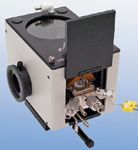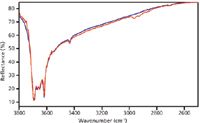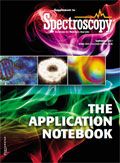Low Temperature Analysis of Kaolin Clay Using Diffuse Reflectance
Application Notebook
Clays, like kaolinite and smectite, are hygroscopic and it is well known that the adsorbed water can be driven off at elevated temperatures. At very low temperatures, in addition to the typical band narrowing and shifting, changes in the O-H bond vibrational modes of clays have also been observed.
Clays, like kaolinite and smectite, are hygroscopic and it is well known that the adsorbed water can be driven off at elevated temperatures. At very low temperatures, in addition to the typical band narrowing and shifting, changes in the O-H bond vibrational modes of clays have also been observed. This note explores changes in kaolin spectrum at temperatures down to -23 °C.
Experimental
The spectra were taken using a Praying Mantis™ diffuse reflectance accessory equipped with its high temperature reaction chamber and cooling cartridge (Figure 1). The cooling cartridge was connected to a Julabo F25-ED refrigerating/heating circulator and the sample was examined at temperatures from ambient to -23 °C. 8 min after achieving thermal equilibrium, infrared spectra from the 4000 cm-1 to 600 cm-1 were recorded using a commercial FT-IR spectrometer. Spectra were signal averaged over 32 scans at an 8 cm-1 resolution.

Figure 1: The Praying Mantis diffuse reflectance accessory, equipped with its high temperature reaction chamber and cooling cartridge.
Results and Discussion
Figure 2 shows a portion of the spectrum of kaolin recorded at two different temperatures. Cooling results in the emergence of two peaks at 2960 cm-1 and 2850 cm-1 in addition to a peak shift in the band at 3434 cm-1. Band shifts and emergence of bands are typically associated with changes in temperature. Note that the low temperature here was limited by the chiller which was designed for operation down to -28 °C. Low temperatures, down to -95 °C, could be achieved by this method using an appropriate chiller and coolant.

Figure 2: Diffuse reflectance spectrum of kaolin, measured at ambient temperature (blue) and at -23 °C (red).
Conclusion
The low temperatures achieved were sufficient to observe minor changes in the kaolin spectrum but were not sufficient to induce previously reported O-H vibrational changes. The Praying Mantis with its cooling cartridge and an appropriate chiller can be used effectively for moderately low temperature experiments.
Special thanks to Christine Anderson, JULABO.
Harrick Scientific Products, Inc.
Box 277, Pleasantville, NY 10570
tel. (914) 747-7202, fax (914) 747-7209
Website: www.harricksci.com

Thermo Fisher Scientists Highlight the Latest Advances in Process Monitoring with Raman Spectroscopy
April 1st 2025In this exclusive Spectroscopy interview, John Richmond and Tom Dearing of Thermo Fisher Scientific discuss the company’s Raman technology and the latest trends for process monitoring across various applications.
A Seamless Trace Elemental Analysis Prescription for Quality Pharmaceuticals
March 31st 2025Quality assurance and quality control (QA/QC) are essential in pharmaceutical manufacturing to ensure compliance with standards like United States Pharmacopoeia <232> and ICH Q3D, as well as FDA regulations. Reliable and user-friendly testing solutions help QA/QC labs deliver precise trace elemental analyses while meeting throughput demands and data security requirements.